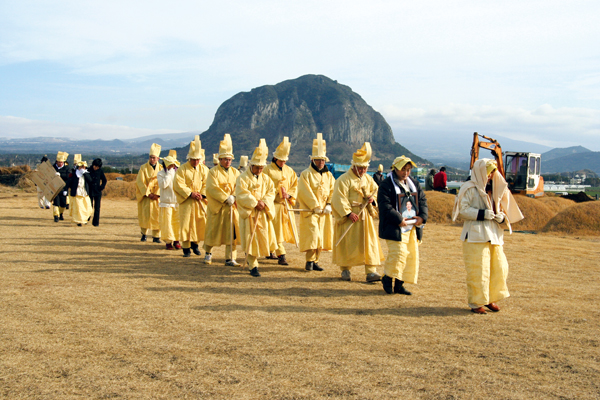- Death, burial and bereavement customs of Jeju, part I
 |
||
How do we honor our dead?
Traditional methods of burial, bereavement, and remembrance are a defining feature of any culture. Those of Jeju highlight its cultural uniqueness. Steeped in the indigenous shamanic religion, local traditions of burying the dead also draw upon the complex cultural milieu that is Jeju.
These rituals additionally serve to highlight the very complicated status of Jeju women.
Independent scholar Kim Yu Jeong of the Jeju Culture Institute has made this study his life’s work. His office is stacked to the ceiling with resources, his computer equally filled with photographic evidence. He has written multiple articles on this topic for a number of newspapers and finds it endlessly fascinating.
“I will study this to the day of my own death,” he said. “Even though others, including my own parents, cannot understand my interest, it captures me completely.”
In many cultures there exists a ‘psychopomp,’ from the Greek word ‘psychopompos,’ which literally means ‘guide of souls.’ This being, which takes different forms from one culture to the next, ushers the souls of the recently deceased to the afterlife.
The shaman often serves this role, as is the case in Jeju. Kim is another such representation, undergoing his scholarly quest to understand Jeju’s related traditions and share that knowledge with others. The psychologist, in mediating between the conscious and unconscious, is yet a third example.
Jeju people have a deep connection with the dead, between their world and the afterlife. As is true throughout Korea, though the customs differ, a formal and regular remembrance of one’s ancestors is imperative to the health of the family.
A Jeju gravesite is located not in the mountains, as in the mainland, but on farmland. In this agrarian society, fertile land is sacred.
Ancestors are thus kept near the family, and there are two gates in the stone walls that surround burial mounds: one to provide regular access for family members, the other for the spirits to travel to and fro as they wish.
Families often have meals at gravesites as a way of continuing their relationship with the ancestors. This is similar to customs in Latin America.
A Jeju gravesite, deceptively simple in appearance, is rich in symbolism.
The deceased are buried in accordance with principles of geomancy and in harmony with the energy lines and features of the land itself. A stone altar is placed at the head of the grave and on it are three smaller stone tables for foods and sacred objects.
An additional small stone table is placed on this altar in a position closest to the grave itself. This is the “seat” for the spirit of the deceased. The tombstone is nearby, and indicates the deceased’s lineage, name, position and status, though these are severely limited on the tombstones of females.
Jeju people prepare for their funerals well in advance, beginning typically around the age of 60. The tombstone often stands near the home for years before being placed at the gravesite after death.
Guarding over the gravesite are three statues in addition to the tombstone. The ‘dongjaseok’ is the least in order of priority, its image one of an errand boy to the spirits. Next in importance is the ‘mangjuseok,’ a column which serves to officially mark the grave but is not the tombstone. The most significant of these statues, the ‘muninseok,’ indicates the status of and acts as servant to the deceased.
In a far corner of the gravesite, a smaller altar exists for the spirits of the land itself. In the burial ritual, the first act is one of supplication to the spirits of that location, the “true owners” of the land according to Kim, to honor them and obtain their permission to bury.
The arrangement of the gravesite speaks to some of the deepest underpinnings of Jeju’s culture: a connection to the earth and nature spirits, belief that ancestral spirits continue to exist and commune with as well as directly influence the living, and a benign relationship with death.
Part II: Rituals of Burial and Mourning; Part III: Concept of Afterlife
(Interpretation by Song Jung Hee)
Dr. Hilty is a cultural health psychologist living on Jeju Island.
Anne Hilty eastwest.psyche@gmail.com
<저작권자 © 제주위클리 무단전재 및 재배포금지>






